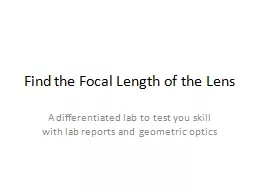

A differentiated lab to test you skill with lab reports and geometric optics Ray Tracing for Lenses Lenses are used to focus light and form images There are a variety of possible types we will consider only the symmetric ones the double concave and the double convex ID: 918154
Download Presentation The PPT/PDF document "Find the Focal Length of the Lens" is the property of its rightful owner. Permission is granted to download and print the materials on this web site for personal, non-commercial use only, and to display it on your personal computer provided you do not modify the materials and that you retain all copyright notices contained in the materials. By downloading content from our website, you accept the terms of this agreement.
Slide1
Find the Focal Length of the Lens
A differentiated lab to test you skill with lab reports and geometric optics
Slide2Ray Tracing for Lenses
Lenses are used to focus light and form images. There are a variety of possible types; we will consider only the symmetric ones, the double concave and the double convex.
Slide3Ray Tracing for Lenses
If we think of a convex lens as consisting of prisms, we can see how light going through it converges at a focal point (assuming the lens is properly shaped).
Slide4Ray Tracing for Lenses
A concave lens can also be modeled by prisms:
Slide5Ray Tracing for Lenses
These diagrams show the principal rays for both types of lenses
:
The three principal rays for lenses are similar to those for mirrors:
The
P
ray—or parallel ray—approaches the lens parallel to its axis.
The
F
ray is drawn toward (concave) or through (convex) the focal point.
The midpoint ray (
M
ray) goes through the middle of the lens. Assuming the lens is thin enough, it will not be deflected. This is the thin-lens approximation.
Slide6Ray Tracing for Lenses
The convex lens forms different image types depending on where the object is located with respect to the focal point:
Slide7The Thin-Lens Equation
We derive the thin-lens equation in the same way we did the mirror equation, using these diagrams:
Slide8The Thin-Lens Equation
Sign conventions for thin lenses:
Slide9The focal Length can be found…
Using the equations seen yesterday, your single objective is to find the focal length of the convex lens that is in your group’s optics kit.
The way you communicate your findings will dictate your grade. There are several options to choose from.
Slide10The ‘D’ Option
This option will earn you up to a ‘D’ or 69%
You provide an answer for the focal length with the measurements and math. Minimal to no commentary on procedure and analysis.
f = 15.0
cm
Slide11The ‘C’ Option
This option will earn you up to a ‘C’ or 79%
You provide an answer for the focal length with the measurements and math. A clear and concise commentary is given on the procedure and analysis used.
Slide12The ‘B’ Option
This option will earn you up to a ‘B’ or 89%
You provide an answer for the focal length with the measurements and math. A clear and concise commentary is given on the procedure and analysis used. More than one pair of object and image distances are used to calculate the focal length.
Trial
#
d
o
d
i
f
1
2
3
Slide13The ‘A’ Option
This option will earn you up to an ‘A’ or 100%
You provide
an answer for the focal length with the measurements and math. A clear and concise commentary is given on the procedure and analysis used.
More than one pair of object and image distances are used to calculate the focal length. A graph of the data is shown to depict how the focal length can be visualized as the slope of a function relating d
i
and d
o
.
Slide14The Options for the Lab
Y
our single objective is to find the focal length of the convex lens that is in your group’s kit.
All of the levels allow you to do this, and they all build on each other. Ex: In order to do the B-level, you must be able to do the C-level workAdd a ray-diagram to any level for a polished look!
The
options for this lab
D –Level
Find an
answer for the focal length of your convex lens
C-level
Find a
focal length and explain how you obtained it.
B-Level
Use multiple data points to minimize
error in your focal point value.
A-Level
Use multiple data points and graphical analysis to minimize errors in
results
.